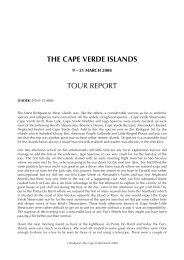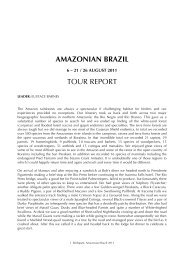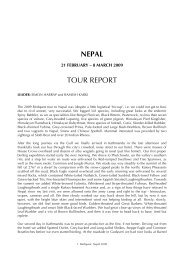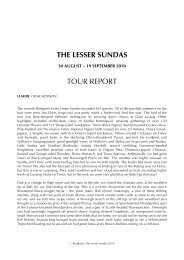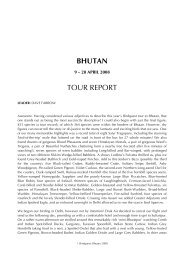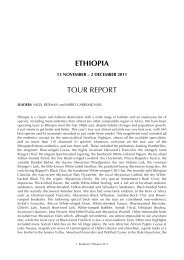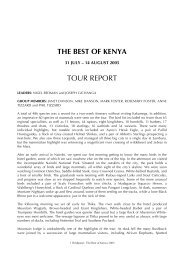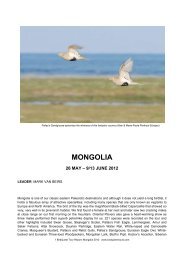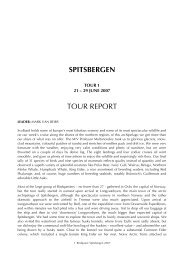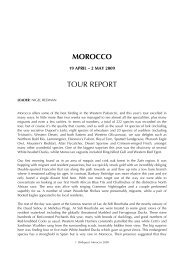Download Full Tour Report 1202kb - Birdquest
Download Full Tour Report 1202kb - Birdquest
Download Full Tour Report 1202kb - Birdquest
Create successful ePaper yourself
Turn your PDF publications into a flip-book with our unique Google optimized e-Paper software.
FRINGILLIDAE<br />
Hooded Siskin Carduelis magellanica: Nearly 100 seen between Huacarpay and Paucartambo and a<br />
few more seen at Lomas de Lachay.<br />
Olivaceous Siskin Carduelis olivacea: A few good looks at this siskin in humid habitats at lower and<br />
middle elevations of the Manu Road.<br />
White-lored Euphonia (Golden-bellied E) Euphonia chrysopasta: A pair showed well from the<br />
canopy tower at Manu Wildlife Centre.<br />
Orange-bellied Euphonia Euphonia xanthogaster: Most numerous at lower elevations along the<br />
Manu road. Here the race brunneifrons, males of which have a rufous crown, and a fairly<br />
ochraceous tinge below.<br />
Rufous-bellied Euphonia Euphonia rufiventris: Excellent close-ups in the garden of Manu Wildlife<br />
Centre.<br />
Blue-naped Chlorophonia Chlorophonia cyanea: Near Cock-of-the-Rock Lodge we enjoyed two<br />
good sightings of roadside bird.<br />
MAMMALS<br />
Saddleback Tamarin Saguinus fuscicollis: A few encounters with this small, nervous primate, The<br />
subfamily of tamarins and marmosets differ from the cebid new-world monkeys<br />
(capuchins, spiders, etc.) by giving birth to twins, having female-dominant family groups,<br />
and by their specialized feeding habits.<br />
White-fronted Capuchin Monkey (Brown Pale-f C) Cebus albifrons: This species travels in larger<br />
groups than the following species. We had good views of a large troop at Manu Wildlife<br />
Centre On average, they forage in taller trees than the Brown Capuchin and also differ in<br />
that one dominant male does not govern them as in that species.<br />
Brown Capuchin Monkey (Black-capped C) Cebus apella: Widespread in South America and highly<br />
intelligent. In northeast Brazil I was the first to confirm tool-use in a family group of this<br />
species that actually used large round stones in a Schwarzenegger dead lift to break open<br />
Attalea palm nuts. Photographs by Peter Oxford of this same family of monkeys were<br />
recently featured in the January 2003 issue of BBC Wildlife.<br />
Black-headed Night Monkey Aotus nigriceps (H): Their owl-like hoots were heard on our night walk<br />
at Manu Wildlife Centre.<br />
Brown Titi (Dusky T-Monkey) Callicebus brunneus: Five seen at Pantiacolla and two more seen at<br />
Romero.<br />
Common Squirrel Monkey Saimira sciureus: An active insectivore that moves in large groups and<br />
cover huge territories, some days up to five kilometres. These large troops are governed<br />
by groups of females who make alliances and dominate the males!<br />
Red Howler Monkey (Red H) Alouatta seniculus: Entertaining moments watching these mostly<br />
folivorous primates.<br />
Peruvian Spider Monkey Ateles chamek: Several sightings of this hefty (over 25 lbs (12 kilos))<br />
arboreal acrobat foraging in the floodplain forest around Romero and Manu Wildlife<br />
Centre. Spider monkey taxonomy is quite complex; this form of southwest Amazonía<br />
(including Manu) is now considered a separate species. A Red List species classified as<br />
Least Concern.<br />
Common Woolly Monkey Lagothrix lagothricha: First spotted by Martine and François along the<br />
Manu road. We also had an exciting encounter with these debris-throwing, muscular<br />
frugivores in the terra firme at Amazonía Lodge.<br />
South American Coati Nasua nasua: One of our best mammal sightings was watching a family group<br />
cross the Manu road below Pillahuata.<br />
Kinkajou Potos flavus: We had good daytime views of this normally nocturnal critter feeding in<br />
cecropias above Cock-of-the-Rock Lodge.<br />
42 <strong>Birdquest</strong>: The Manu 20011




